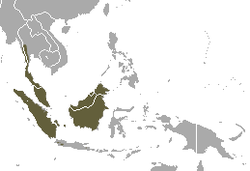Banded linsang
| Banded linsang[1] | |
|---|---|

| |
| Conservation status | |
| Scientific classification | |
| Kingdom: | Animalia |
| Phylum: | Chordata |
| Class: | Mammalia |
| Order: | Carnivora |
| Family: | Prionodontidae |
| Genus: | 'Prionodon' |
| Species: | ''P. linsang'' |
| Binomial name | |
| Prionodon linsang (Hardwicke, 1821)
| |

| |
| Banded linsang range | |
- 15px|link=|alt= Wikimedia Commons alberga una categoría multimedia sobre [[Commons:Category:Script error: The function "Wikidata" does not exist.|Banded linsang]].
The banded linsang (Prionodon linsang) is a linsang, a tree-dwelling carnivorous mammal of the Malay peninsula, Sumatra, Borneo, and western Java.
Description
[edit]The banded linsang is around 74 cm long including the tail. It is a pale yellow with 5 dark bands. It has broad stripes on its neck and its tail consists of several dark bands with a dark tip. The banded linsang has very sharp retractable claws and razor sharp teeth. It is the rarest of the civets, and is sometimes called the tiger-civet.
Diet
[edit]The banded linsang is carnivorous. Its diet consists of squirrels, rats, birds, and lizards.
Reproduction
[edit]Very little is known about this linsang's reproduction. It is believed that litters of 2-3 are born semiannually in a nest in burrows or hollow trees.[3]
Habitat
[edit]The banded linsang lives in Western Malaysia, Sumatra, Borneo, Western Java, and Thailand. It lives in tropical forests and spends the majority of its time in trees.
References
[edit]- ^ Template:MSW3 Wozencraft
- ^ Template:IUCN2008 Database entry includes a brief justification of why this species is of least concern.
- ^ Whitfield, Philip, ed. (1984). Macmillan Illustrated Animal Encyclopedia. Macmillan Publishing Company. p. 92. ISBN 0-02-627680-1.
External links
[edit]- Pages with script errors
- Pages using the JsonConfig extension
- IUCN Red List least concern species
- Articles with 'species' microformats
- Taxoboxes with the error color
- Taxobox articles possibly missing a taxonbar
- Viverrids
- Mammals of Indonesia
- Carnivora of Malaysia
- Mammals of Thailand
- Fauna of Sumatra
- Mammals of Borneo
- Animals described in 1821

